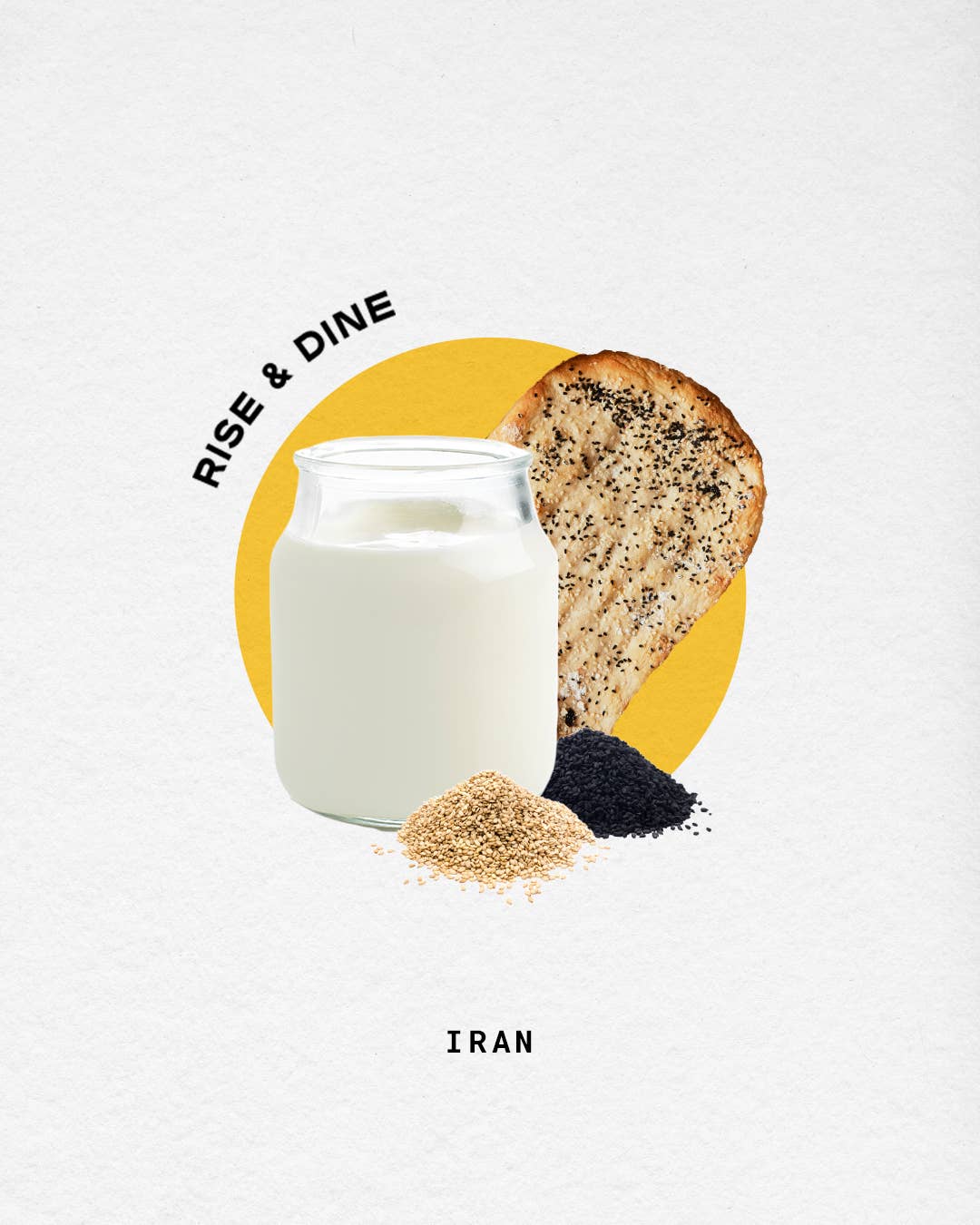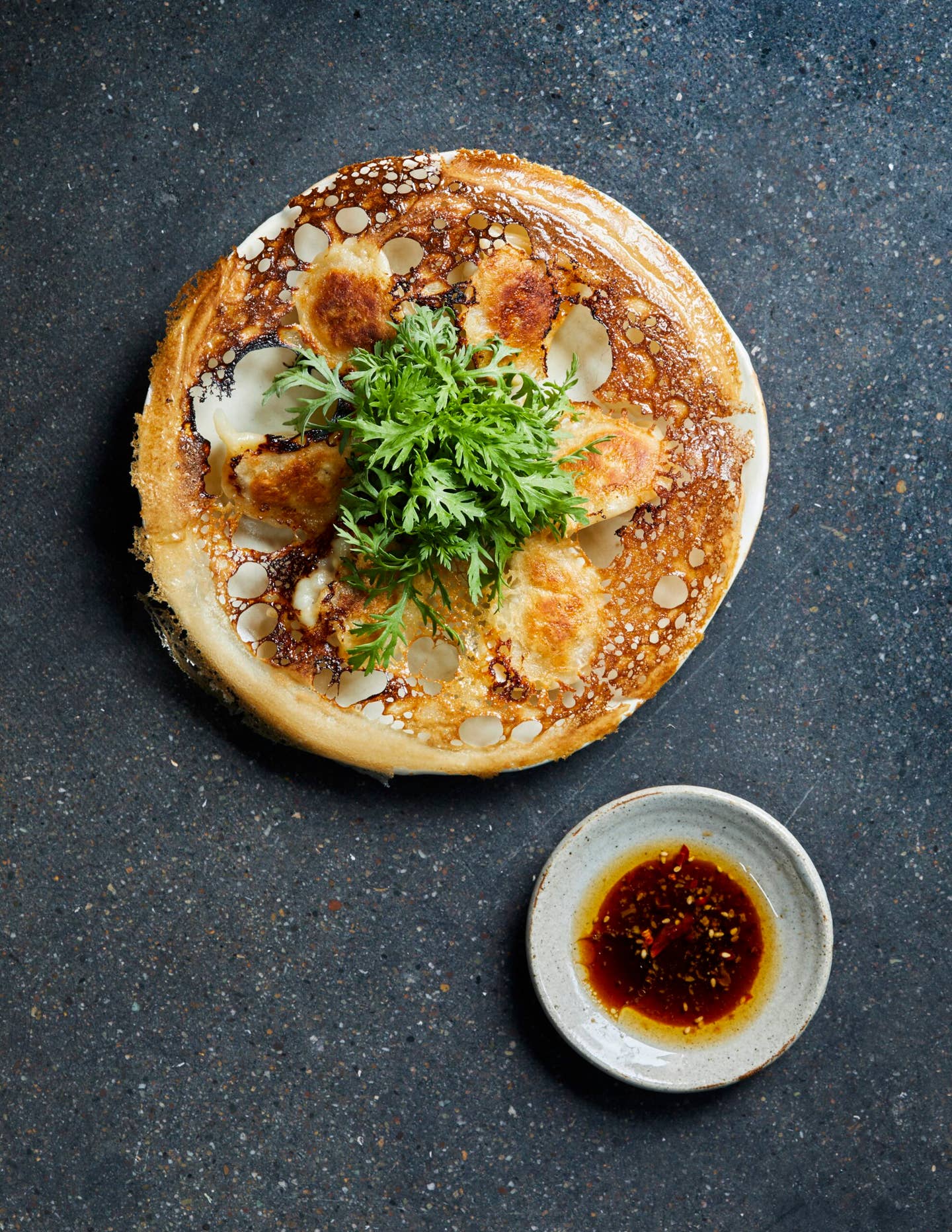Feasting with Purpose
How crispy tahdig, rose-scented love cake, and barbari bread are helping advocate for human rights.

Search #CookForIran on Instagram and a sea of bright, lovingly plated dishes populate the results: a Seattle restaurant serving up lubia polo, a comforting and aromatic dish of rice, green beans, and spiced meats; a home cook in New Zealand sharing a goblet of ab-havij bastani, a luxurious ice cream float made with refreshing carrot juice; a warm platter of Iranian American cookbook author Naz Deravian’s tahcheen-e morgh, tangy saffron-spiced yogurt rice with juicy chicken, baked to bronze perfection for a table of lucky diners in Germany. The strangers cooking these Iranian delicacies haven’t met in real life, but online, they’ve come together to support a common cause.
Humanitarian and entrepreneur Layla Yarjani conceived the idea of #CookForIran while coordinating charity partnerships and operations for #CookForSyria and #CookForUkraine, food-driven campaigns raising awareness for the humanitarian crises in both countries. In Iran, mass protests have shaken the nation since September 2022, when a 22-year-old woman named Mahsa Amini was arrested by local morality police for not wearing a hijab in accordance with the strict laws. Witnesses say Amini was severely beaten and fell into a coma; she died three days later in police custody. The tragedy sparked widespread outcry on social media and mass demonstrations in the streets of Iran. “People are just asking for basic human rights,” says Yarjani. According to Human Rights Watch, authorities in the country have brutally clamped down on dissent and opposition, and thousands of protesters have been detained, imprisoned, or sentenced to death. Both the uprising and the government’s lethal crackdowns have drawn unprecedented levels of global attention to the oppression millions of women continue to face in the country.
As the demonstrations dominated worldwide news coverage, Yarjani wanted to help amplify global awareness about human rights advocacy in Iran, while resisting characterizations of the country and culture as a monolith defined by its politics. In October 2022, she and fellow activist Omid Scheybani kicked off #CookForIran on Instagram, with a basic rice recipe from cookbook author Najmieh Batmanglij. “When people eat the food from a particular country, they really start to appreciate the culture and connect that food with the people in a more visceral way,” says Yarjani. Since the initiative’s launch, hundreds of cooks around the world have joined the cause by sharing images of vibrant, tantalizing dishes like borani esfenaj, a cool and creamy yogurt dip, and shushtari polo, featuring crispy, golden rice and savory meatballs.
“Iran has been a country and a culture that has been misunderstood a lot by the West, especially in the U.S.,” explains Iranian American cookbook author Andy Baraghani. By bringing the voices of individual people—be they demonstrators, activists, supporters, or well-wishers—to the surface, #CookForIran reminds the world that there are real faces and families being impacted by the events there. “Humanizing any society is the first step in having the world care about them,” says Tara Kangarlou, an Iranian American journalist and author of The Heartbeat of Iran.
Yarjani understands that many people may feel unsure how to best express their support for the Iranian community. “Some of the content coming out of [Iran] is so difficult for people to grasp,” she says. Many members of the Iranian diaspora who still have family in the country are also understandably careful about their speech, says Kangarlou, explaining that the regime has punished many people for outspoken criticism or solidarity. The journalist is among those unable to return to Iran, as her past reporting has shed light on the regime’s human rights record. Food, though, can be a “subtle way to raise awareness—a way that will inspire more people to get involved,” says Yarjani, emphasizing that #CookForIran is simply championing human rights and can allow people to advocate for Iranians from afar without being explicitly political. “I think it's commendable that [advocates] are cautious while doing all they can to tell the Iranian story,” adds Kangarlou.
The #CookForIran campaign also encourages people to donate what they can to The Center for Mind-Body Medicine, an organization providing trauma therapy training to community leaders, physicians, teachers, and other individuals on the ground in Iran, as well as remote mental health support services. Many well-known tastemakers, including chefs Yotam Ottolenghi and Marcus Samuelsson, and cookbook author Najmieh Batmanglij, have joined the initiative, adding Iranian dishes to their restaurant menus or sharing recipes with their social media followers to raise both funds and awareness.
For Iranian-born cooks, these acts take on even more meaning, as preparing Iranian dishes has long been a way for many to keep their heritage and country close. Food is “a really accessible way to connect with a culture,” says Nilou Motamed, an Iranian American food personality and judge on Netflix’s Iron Chef whose childhood memories are peppered with instances of food as fuel, refuge, and community. She fondly recalls going for early-morning treks in the mountains north of Tehran, where humble tea houses offer hikers a warming respite. “You're freezing cold, and you just want to get some tea and then some hot bread—which is, I think, the canvas of the Persian breakfast ritual,” says Motamed. Sometimes she’d choose sangak, baked on top of a layer of little stones; other days, it was lavash, a thin flatbread traditionally made in a clay oven. But her favorite breakfast was barbari, a crisp yet soft, plush bread topped with sesame seeds and served with sweet or savory accompaniments like feta cheese, sour cherry jam, butter, and honey.
Today, Motamed treasures any opportunity to bake fresh barbari for breakfast in her New York City kitchen and relive those memories. “The traditions that you take for granted when you’re in Iran are things that you have to create elsewhere,” she says. “This one little act of making barbari at home makes me feel more connected and more rooted in a culture that I miss so much.”
The team behind #CookForIran hopes the campaign will ensure the world continues “keeping Iran in their hearts and minds,” says Yarjani. “We want people in Iran to feel like they're being seen and they're being heard, and that they have people's goodwill.” With these stakes, it’s clear that images of torshi seer and ash-e reshteh carry far more weight than the typical food snaps shared online. Resistance can come in many forms. Sometimes, it’s a plate of kuku sabzi, humanizing and advocating for the culture behind it.
Recipe
Keep Reading
Continue to Next Story










